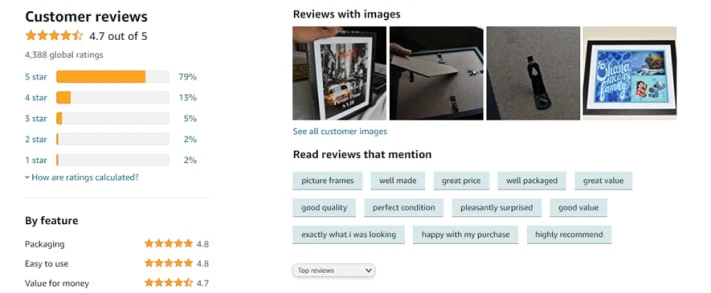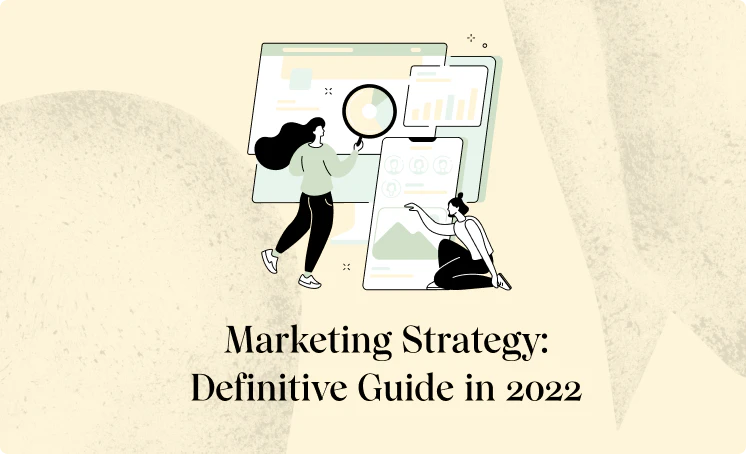Introduction
Big and small brands alike understand the power of using Amazon as a sales channel.
Maybe you’ve decided you want to harness that for your own business as well and are looking to learn how to sell on Amazon.
From determining costs to finding a product to fulfillment, this article has you covered.
Are you ready?
Great! Let’s start by looking at the upfront investment.
How Big Of An Investment Do You Need To Sell On Amazon?
There is not a one-size-fits-all answer to this. Many Amazon brands have started with as little as $500, but that is a lean start.
A better estimate would be into the low four-figures accounting for inventory, fees, tech and tools, and marketing.
When accounting for how much it used to cost to open retail space, that’s only a tiny fraction of the price!
The amount of money you need to start is dependent on:
1) Inventory and Fees (including Amazon seller account, UPCs, packaging, and samples if applicable)
2) Your chosen suppliers MOQ
3) Your marketing plan (PPC ads, social ads, giveaways)
4) Legal fees (Trademark if applicable)
5) Any professionally outsourced tasks (product photography, graphic design, copywriting)
If you are starting an Amazon business from nothing, you’ll want to be able to test a few products instead of putting all your eggs in one basket.
You’ll need to find products and suppliers that allow you to start with small amounts of inventory to try it before committing to 5,000 units to lower your upfront investment costs.
Once you’ve found a few potential supplies, you’ll want to have them create samples for you. This is not a step you can skip to save money if you are looking to private label a product.
You have to know they can produce a quality product or risk ending up with boxes of items that you’ve wasted your money and time on that you’d never be able to sell.
Your product supplier may provide packaging, or you may opt to get your packaging elsewhere if you aren’t satisfied with what they can provide. Don’t forget to ask your supplier about what packaging they offer and the costs to customize (if that’s an option).
Amazon also requires that all products have a unique UPC that you’ll need to purchase separately.
Marketing is another necessary cost to start selling on Amazon.
Without marketing, no one knows your product exists, and you cannot make sales.
Amazon offers PPC ads on its marketplace, but you can also run social ads or participate in giveaways.
Before you decide on your final product(s), you’ll want to determine your marketing strategy and set a realistic budget.
Extra costs that are not a must but you may find beneficial are the fees associated with trademarking your brand/products, professional photography, graphic design for product photos or packaging, and copywriting for your listing.
You can start without any of those things to save money until you know you have a winning product, though.
According to data from JungleScout, more money doesn’t mean more success when it comes to Amazon start-up investment. They found that sellers who started with $500 fared better than sellers who invested $10,000+ to get up and running.
Don’t take that to mean you shouldn’t invest where it makes sense, just that money alone isn’t the answer.
The best way to keep your start-up costs lower? Learn as much as you can before you start selling.
Anytime you jump into a business without educating yourself thoroughly first, you’re going to end up spending more money.
Starting With Amazon FBA
Amazon FBA means that product orders are fulfilled by Amazon.
Once you’ve sourced and sampled your initial products (and handled all the setup pieces like UPCs), you can start having your inventory shipped directly to Amazon.
Then, when a customer places an order, Amazon will pull your product from one of their warehouses and ship it to your customer for you.
This takes away the need for you to worry about having a space large enough for inventory or spending your weekends packing and shipping orders.
Amazon FBA allows you to focus on finding new product opportunities, marketing, customer service, and optimizing your sales process.
Two other significant benefits of using the FBA program are that 1) it makes your products Prime-eligible and 2) it allows Amazon to track your inventory to make sure it’s always in stock.
Both of these things make your products more favorable to Amazon’s algorithm.
While Amazon doesn’t explicitly come out and say it, it gives preference to products in the FBA program.
If you don’t already have a Professional Seller Account on Amazon, that’s your first step after sourcing your products.
After that, you’ll want to create your product listing and let Amazon know it will be in FBA inventory.
Before shipping your items, you’ll want to review Amazon’s packing guidelines and shipping requirements.
You’ll want to ship the first order or two to yourself so you can inspect each product before forwarding the inventory to Amazon to be safe.
You then have two options for how to handle shipping your products to Amazon from your manufacturer.
1) Ship all inventory straight to Amazon
2) Ship to a third-party that will inspect and store your products
While Amazon fulfilling your orders takes out a lot of the hassle on your end, it isn’t for free.
Amazon charges a fee for every item shipped based on category and size. There is also a monthly storage fee and a long-term storage fee.
Even though it saves you money to purchase in larger quantities, these storage fees can add up over time and cut down on your profits.
Due to this, when you start ordering large volumes, you may opt to store most of your product at the third-party facility that will send products to Amazon warehouses as necessary.
Another benefit of third-party storage is that they will inspect your products for you. Meaning you don’t have to worry about defective products getting shipped out to your customers.
The third-party storage will still charge a fee, but it should be lower than what Amazon costs.
However, if you are dealing in smaller product quantities that move quickly and have faith in your supplier, shipping directly to Amazon makes sense.
Take a look at Amazon’s FBA and storage fees to determine what’s the best choice for your products.
Amazon will keep track of your inventory for you and notify you when it’s time to replenish.
You’ll just need to know the production and shipping times on each of your products.
How To Find Products For Amazon
The first step of every Amazon business is coming up with the product(s).
If you’re an established brand, you already have this part covered.
But if you’re new, below are five ways to find the best products.
CONDUCT MANUAL AMAZON RESEARCH
One of the best places to find products to sell is on Amazon itself.
You can check out Amazon’s New Releases and Most Wished For pages to look for products that are starting to gain popularity.
Every product page on Amazon can generate new ideas through the “Frequently Bought Together” and “You Might Also Like” sections.
It helps if you have some product ideas to start with because if not, you can become overwhelmed quickly with the volume of products to sift through.
Once you know what type of products you think you want to sell, you can start using Amazon to research competitors.
You can look at what products they are promoting through ads, looking at their catalog as a whole, and evaluate where they are missing an opportunity your products could fill.
This will help you to hone in on where you want to be in the market.
FOLLOW THE BEST SELLERS
Another place you cannot overlook on Amazon is the Best Seller page.
It’s not as simple as looking at the first few products in a major category. You need to dig in.
You’ll want to look within the smaller subcategories that you find of interest.
The top 5,000 products are where you’ll want to focus.
I know that the top 5,000 sounds like you’ll start looking at products that aren’t getting enough sales, but for many subcategories, that’s not the case at all.
Amazon is shipping out over a million packages a day.
Best selling products in the top 5,000 are getting plenty of sales.
You’re going to want to look for similar products that are repeating in the rankings. Note any product that you see at least three times.
When you see an item a handful of times, you know that there is enough demand in the market that it can handle more competition, and no one brand already has all the target audience.
LOW COMPETITION OR COMPLEMENTARY PRODUCTS
While they aren’t always easy to come across, some products have less competition than others on Amazon.
When you search, you want to look for at least 2-3 listings on the first page with limited reviews (less than 50). If every item on the first two pages of Amazon is well-established, it’s going to be incredibly hard to gain traction.
Often the products that are lower competition are products that are a complement to newly popular products that haven’t been recognized yet.
Take a look at items in New Releases, but not from the angle of what changes you could make to that product as you did initially. This time you want to think about what other products could pair well or if the item would support any type of “accessory.”
Sometimes doing something as simple as creating a product and accessory bundle can set you apart from your competitors.
FIND A HOLE IN THE MARKET WITH KEYWORDS OR GOOGLE TRENDS
As you’re searching, you may stumble upon a suggested long-tail keyword that doesn’t have listings that are a good match for the term.
Even though the products may be on the marketplace somewhere, the sellers aren’t targeting the best keyword(s).
Check some other related keywords and see if that is a continued trend. If so, and there is enough search volume, that signals an opportunity.
Amazon isn’t the only place that can tell you what is popular.

Google tracks what keywords are being searched over a period of time to identify data trends.
You can use this information to watch for a sudden spike in product searches or see if an item is on a downturn.
Given that Amazon is a marketplace powered by a search engine, using keyword data to help you select the right product can give you an advantage.
CONSIDER NICHE EXPERTISE
Beyond using Amazon, or any other online tool, you should be considering any niche expertise that you have.
When you are part of your target audience, you understand both what the market wants and what products are currently available that aren’t working well.
You’ll understand how to market and demonstrate the product better than someone who only sells it but doesn’t use it themselves.
If you’re looking to build a brand, picking a niche you enjoy is often your best bet.
10 Steps To Sales: How To Sell Products On Amazon
MAKE A PLAN
Every business should start with a business plan.
A plan helps guide your decisions and keeps you on track.
Your plan should include the type of products you are going to sell (niche), market research, competitor analysis, marketing plan, and your budget at least.
The plan should establish measurable goals with timelines, so you have something to measure your progress against.
Understand that your plan will need to be adjusted as your business grows, so this doesn’t have to be a plan for the next five years. Start with the next six months and re-evaluate at that time what is and isn’t working.
IDENTIFY YOUR AUDIENCE
Now that you know what products you are looking at, you need to determine what audience you’re targeting.
Many products have more than one audience you can address.
For instance, you can sell an ottoman that doubles as storage to minimalists looking for products that serve multiple purposes, or you can sell those same ottomans to parents who are looking for a way to keep their house both attractive and functional.
While there may be some overlap between the two audiences, you would need to decide which one you will focus on targeting with your keywords and marketings.
COLLECT AUDIENCE INSIGHTS

Once you’ve picked your audience, it’s time to learn as much as you can about them.
You need to know more than their surface-level problems and find out exactly how they are finding your products, what they are looking for, and why the other solutions out there aren’t working.
A gold mine for this information is product reviews on similar products.
Another great place to look is on forums like Reddit, where your customers ask fellow members of your audience for advice or product suggestions.
And never forget about utilizing the power of Google.
For the example above, you could search “best storage ottomans” and look at what popular sites recommend.
You can learn from those recommended products’ reviews, messaging, and marketing.
LOCATE A SUPPLIER
All of your efforts have paid off, and you know what products you want to sell and who you’re selling to.
It’s time to find a supplier who can manufacture for you.
Take your time to find suppliers with positive reviews and who are willing to accommodate small order quantities initially.
Don’t forget to order samples from a few of the suppliers to test the product quality, as well as how easy those suppliers are to communicate with and what the shipping process is like.
When you’re working with a manufacturer, the absolute lowest price isn’t the only thing that matters.
It’s worth it to pay a little more for a responsive supplier that easily understands what you are looking for.
SET UP A SELLER ACCOUNT

You cannot sell on Amazon without a seller account. Amazon offers a professional seller account that costs $39.99/month, or you can create a free individual seller account that will take $0.99 for every sale you make.
If you aren’t sure how many sales you will make a month, you might opt for the free option, but it has limitations you need to be aware of.
With the individual plan, you cannot use native advertising or sell in certain restricted categories.
If you don’t plan to advertise on Amazon at first, then the free plan may be fine until you start making at least 40 sales per month.
ORDER INVENTORY
You’ve talked with your potential suppliers, checked out the samples, and learned all the details, and now it’s time to order your first round of inventory.
While you’ll likely want to order the smallest quantity your supplier allows at first, if you’re private labeling your product, you don’t want to order too little, or you risk running out of inventory quickly and losing any you’ve built momentum.
Amazon prefers products that stay in stock, so take this into account along with your total cost per unit (including shipping and product packaging) and budget when deciding on your first round of inventory.
SET UP YOUR LISTINGS

Your listing consists of your product title, product description, and product images.
Each of those pieces will need to be optimized.
Your product title should accurately describe your product and ideally contain your most relevant keyword.
Many shoppers are on mobile, so aim to keep your title around 70-80 characters to avoid important information from being cut-off.
The product description should be conversion-focused, not keyword-focused. Add keywords where appropriate, but your description should highlight key product benefits and answer any questions your customers might have above everything else.
On Amazon, your product images are just as important as your title and description.
Many shoppers will look at your images before they take the time to read the product details.
The main image has to be of only your photo on a white background, but your other images should showcase your product in different ways.
Many products are enhanced with images with added text and graphics explaining the main features and benefits.
DECIDE HOW YOU WILL MANAGE INVENTORY
We’ve discussed getting set up with Amazon FBA above, and while that’s the recommended option for many small and lightweight products, it’s not your only option.
You can opt to manage and fulfill your inventory on your own, or you could use a third-party fulfillment center for everything.
If you are selling large and/or heavy items, Amazon may not be the most cost-effective choice.
For items like furniture, Prime is less of a deciding factor for shoppers, so you may be able to ship it yourself (if you have storage) or use a third-party with lower storage prices.
START REVIEW BUILDING
Shoppers trust reviews from other verified Amazon purchases.
As soon as you can, you need to focus on building product reviews.
Amazon has the Early Reviewer and Vine programs you may be eligible for, but only use those programs if you are fully confident in your product because the reviews will be completely honest and will call out any unfavorable features.
Another option is to apply to be included in Amazon’s Giveaway program to get potential reviews.
You can use a strategy like promoting Amazon coupons to get customers to overcome their fear of trying a product without reviews. Hopefully, once they receive the product, they are happy and remember to come back to help build the reviews.
Ultimately, it takes sales to get reviews, so keep trying new ways to build sales, and the reviews will come.
IMPROVE YOUR LISTINGS
The quickest way to lose sales is to have a lousy product listing.
When your customer hits your product page, it has to drive them to buy; otherwise, they can simply hit the back button and choose one of the other options available.
Make sure you’re not giving them a reason to do this.
To improve your product listing, you’ll want to:
- Use all available space for product images
- Have a scannable product description
- Focus on the benefits your audience gets in all copy and images
Be sure you’re monitoring your click-through and conversion rates to see if you need to adjust elements of one or both.
How To Improve Your Product Ranking Fast
We’ve already discussed that Amazon gives preference to products enrolled in Amazon FBA.
You also know that you need to optimize your title, description, and images, so your CTR and conversion rate are good enough to make Amazon recommend your product.
But what if you’ve done these things and your product still isn’t moving up in the ranking?
Amazon offers you something you can’t get on your own site (tons and tons of traffic!), but that doesn’t mean all of that traffic will be easy to get to your product page.
While Amazon is trying to decide if your product is the best option to put in front of their shoppers, you need to give them a reason to be sure.

Paid campaigns can help you get the sales and reviews Amazon needs to feel confident about your product.
If you’re not using Amazon Sponsored Product campaigns, you might want to start.
The right campaign strategy (along with finding the best keywords for your products and getting reviews) is something we can help you develop.
Final Thoughts
Getting started selling on Amazon is more than choosing a product you like and listing it on the site.
To be successful, you need to do the research first and create a plan you can stick to.
In this article, we’ve outlined the steps you need to take to sell products on Amazon, but once you’re set up on the marketplace, you’ll want to dig deeper into topics like keyword research and PPC strategies.














.webp)

.webp)








.webp)









































.webp)






